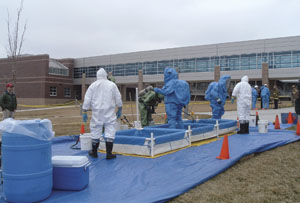Relief Agencies Not Surprised by Kansas City's Response
by David Smale

Kansas City’s leaders learned a lot from what was done wrong—and done right—responding to Katrina.
“We have had numerous discussions about lessons learned,” said Major Tom Dailey, Division Commander of the Kansas City Police Department’s Division of Homeland Security. “There were some local agencies that went down to Katrina. They learned a great deal from some of the mistakes that were made before and after. And many of the agencies in that area did it right.”
Ken Cope, Director of Emergency Services for the Greater Kansas City chapter of the American Red Cross, said, “I think we’d want to avoid large shelters. Those are hard to manage, and I was surprised that anyone tried to do that. I think they had some success in the Astrodome with that. But if we can avoid that here I think we would. It’s a recipe for disaster.”
Still, Dailey says we can’t compare Kansas City to New Orleans. “They’ve got rivers, oceans, lakes, levees. If something happens there, they’ve got to go north. Kansas City is in the middle of the nation, so there are plenty of differences. There were lessons learned about the response, and in particular about the preparation. It is the biggest catastrophe we’ve ever had in this country.”
?So if New Orleans was a failure of the system, what is Kansas City doing differently?
For one, the city’s emergency management forces are in a constant state of training. “We do exercises for floods, tornados, weapons of mass destruction. We don’t do exercises for things that are not likely to happen,” said Christian, who works with Kansas City, Mo., officials and communicates with other similar offices in the region.

“We’re considering now whether it’s appropriate to do an earthquake-based exercise. Although it’s possible that a really dramatic earthquake could happen on the New Madrid Fault (in southeast Missouri), it would take an 8 or greater (on the Richter Scale) to do any damage in Kansas City. Still, the damage would be to freeway overpasses, unreinforced masonry, broken windows and lots of chimneys. In terms of buildings coming down, it’s not going to happen.”
Dailey notes that the exercises are expensive, but that doesn’t stop them from occurring. “This will always be a fluid, evolving field, because the threats change,” he said. “We do a lot of table tops. We certainly talk a lot. But an earthquake scenario would be different from a tornado. There are a lot of different scenarios that would bring a lot of brand new hazards to an area. You’re constantly preparing for various scenarios. But the fact of the matter is you prepare to the best of your ability and then you’re going to have to adapt.”
Shawnee County’s Gary Middleton agrees. “I think preparedness is a dynamic issue,” he said. “It’s always ongoing. I don’t think anyone ever reaches a point where they’re completely comfortable with their level of preparedness.
“You’re either moving ahead or you’re falling behind. You can never rest on past achievements. You have to continue to learn, from exercises and actual emergencies.”
Dailey also points out that there is regional cooperation beyond the limits of Kansas City, Mo. “In 1997, Kansas City was one of 20 cities that was given an MMRS (Metropolitan Medical Response System) Grant. Basically, that merges everyone in an eight-county area (the same counties covered by MARC) to coordinate resources—hospitals, almost anybody who would be a first responder in a critical incident—in preparation to a response to terrorism.”
Preparing for a crisis, and especially once a crisis occurs, different organizations have different roles. The Police Department’s Homeland Security Division’s role is “to ensure our police department and our region are prepared, not only for a response to a terrorist situation, but for the prevention and deterrent of one also,” Dailey said. “A response to a critical incident is a response to a critical incident, whether it’s man-made or a natural disaster.”